
The Dean Cemetery is a historically important Victorian cemetery north of the Dean Village, west of Edinburgh city centre, in Scotland. It lies between Queensferry Road and the Water of Leith, bounded on its east side by Dean Path and on its west by the Dean Gallery. A 20th-century extension lies detached from the main cemetery to the north of Ravelston Terrace. The main cemetery is accessible through the main gate on its east side, through a "grace and favour" access door from the grounds of Dean Gallery and from Ravelston Terrace. The modern extension is only accessible at the junction of Dean Path and Queensferry Road.

Fraserburgh, locally known as the Broch, is a town in Aberdeenshire, Scotland, with a population recorded in the 2011 Census as 13,100. It lies in Buchan in the northeastern corner of the county, about 40 miles (64 km) north of Aberdeen and 17 miles (27 km) north of Peterhead. It is the biggest shellfish port in Scotland and one of the largest in Europe, landing over 5,450 tonnes in 2016. Fraserburgh is also a major port for white and pelagic fish.
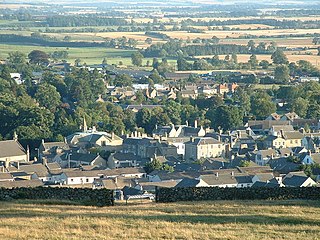
Duns is a town in the Scottish Borders, Scotland. It was the county town of the historic county of Berwickshire.
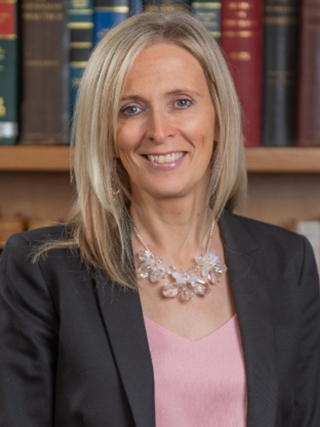
His Majesty's Solicitor General for Scotland is one of the Law Officers of the Crown, and the deputy of the Lord Advocate, whose duty is to advise the Scottish Government on Scots Law. They are also responsible for the Crown Office and Procurator Fiscal Service which together constitute the Criminal Prosecution Service in Scotland.

Allegheny Cemetery is one of the largest and oldest burial grounds in Pittsburgh, Pennsylvania. It is a historic rural cemetery.
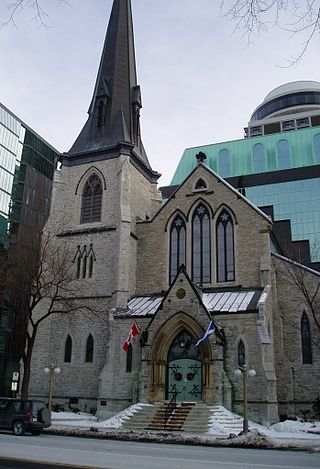
St. Andrew's Presbyterian Church is the oldest Presbyterian church in Ottawa, Ontario, Canada.
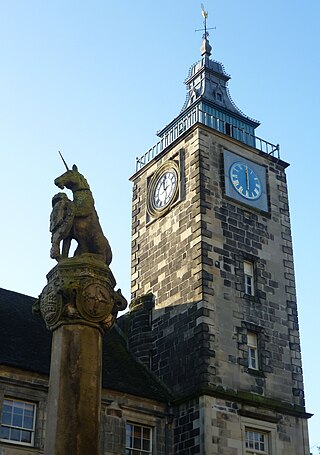
The Radical War, also known as the Scottish Insurrection of 1820, was a week of strikes and unrest in Scotland, a culmination of Radical demands for reform in the United Kingdom of Great Britain and Ireland which had become prominent in the early years of the French Revolution, but had then been repressed during the long Napoleonic Wars.

Prestonpans is a small mining town, situated approximately eight miles east of Edinburgh, Scotland, in the council area of East Lothian. The population as of 2022 is 10,460. It is near the site of the 1745 Battle of Prestonpans. Prestonpans is "Scotland's Mural Town", with many murals depicting local history.

The Glasgow Necropolis is a Victorian cemetery in Glasgow, Scotland. It is on a low but very prominent hill to the east of Glasgow Cathedral. Fifty thousand individuals have been buried here. Typical for the period, only a small percentage are named on monuments and not every grave has a stone. Approximately 3,500 monuments exist here.

The Grange is an affluent suburb of Edinburgh, just south of the city centre, with Morningside and Greenhill to the west, Newington to the east, The Meadows park and Marchmont to the north, and Blackford Hill to the south. It is a conservation area characterised by large early Victorian stone-built villas and mansions, often with very large gardens. The Grange was built mainly between 1830 and 1890, and the area represented the idealisation of country living within an urban setting.

South Leith Parish Church, originally the Kirk of Our Lady, St Mary, is a congregation of the Church of Scotland. It is the principal church and congregation in Leith, in Edinburgh. Its kirkyard is the burial place for John Home and John Pew, the man from whom the author Robert Louis Stevenson reputedly derived the character of Blind Pew in the novel Treasure Island. 18th-century Scottish Episcopal Church bishop and historian Robert Forbes also lies buried beneath the church floor. The church has been repaired, used as an ammunition store and reconstructed but still retains the basic layout of the nave of the old church.
The Scots Charitable Society (est.1657) of Boston, Massachusetts, The oldest charitable institution in the Western Hemisphere, was established to provide relief for local, "needy Scot people, after proper investigation." It "enjoys the distinction of being the oldest Scots society in America." It "became the prototype for thousands of other groups" of private charity in America.
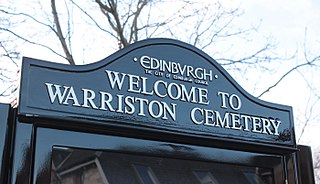
Warriston Cemetery is a cemetery in Edinburgh. It lies in Warriston, one of the northern suburbs of Edinburgh, Scotland. It was built by the then newly-formed Edinburgh Cemetery Company, and occupies around 14 acres (5.7 ha) of land on a slightly sloping site. It contains many tens of thousands of graves, including notable Victorian and Edwardian figures, the most eminent being the physician Sir James Young Simpson.

New Calton Burial Ground is a burial ground in Edinburgh. It was built as an overspill and functional replacement to Old Calton Burial Ground and lies half a mile to its east on Regent Road in Edinburgh, Scotland, on the south-east slopes of Calton Hill. On its southern edge it attaches to the north-east edge of the Canongate in the Old Town. It lies on a fairly steep south-facing slope with views to Holyrood Palace, the Scottish Parliament Building and Arthur’s Seat.
Events from the year 1820 in Scotland.
John Hennen FRSE was an Irish-born military surgeon and author of the acclaimed medical textbook The Principles of Military Surgery.













